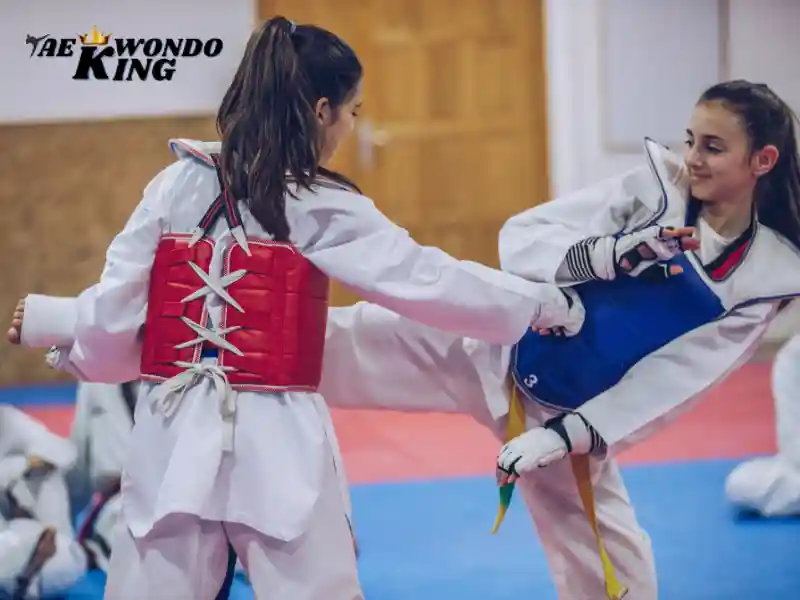
Taekwondo, with its dynamic kicks and powerful strikes, embodies the spirit of the warrior. Yet, like any physical activity, the pursuit of martial arts excellence carries a potential for injury. Understanding these most common injuries empowers you to train smarter, minimize risks, and ensure a smooth journey on your Taekwondo path.
In this article, we will delve into the most frequent injuries that occur in Taekwondo and share tips on how to prevent and treat them to ensure a safe and enjoyable training experience.
Acute Injuries: The Immediate Impact
Muscle Strains and Tears:
These occur when muscles are stretched or torn beyond their capacity. They can be caused by improper form, overexertion, or insufficient warm-up.
Ligament Sprains:
Sprains happen when ligaments connecting bones are stretched or torn. This can happen during landings from jumps or kicks, especially if not executed properly.
Concussions:
While less frequent, head injuries like concussions can occur during sparring if proper protective gear isn’t worn or accidental head contact happens.
Cumulative Injuries: The Long-Term Toll
Shin Splints:
This pain along the shinbone arises from repetitive stress on the muscles and tissues surrounding the tibia. It’s often linked to improper footwear or running techniques.
Patellar Tendinitis:
Repetitive jumping and landing motions can cause inflammation of the tendon connecting the kneecap to the shinbone.
Rotator Cuff Injuries:
Overusing the shoulder joint during throws or strikes can lead to inflammation or tears in the rotator cuff muscles.
Minimizing Risks: Safeguarding Your Path to Excellence
Prioritize Proper Warm-Up:
Dedicate time to dynamic stretches and light cardio to prepare your muscles and joints for training.
Listen to Your Body:
Don’t push through pain. Take rest days when needed and avoid overtraining.
Master Technique:
Focus on proper form to minimize stress on your body and reduce the risk of injuries caused by improper movement.
Choose the Right Gear:
Wear well-fitting protective equipment like padded headgear, mouthguards, and shin guards to absorb impact and minimize the risk of head and leg injuries.
Fuel Your Body:
Maintain a healthy diet and stay hydrated to ensure your body has the necessary resources for optimal performance and recovery.
Communicate with Your Instructor:
Inform your instructor about any pain or injuries you experience. They can adjust your training regimen to promote healing and prevent further complications.
Strategies for a Safe and Fulfilling Journey
Warm-Up and Cool-Down:
Never underestimate the importance of proper warm-ups to prepare muscles for activity and cool-downs to promote recovery.
Listen to Your Body:
Pushing through pain can lead to more serious injuries. Take rest days and listen to your body’s signals for fatigue or discomfort.
The technique is King:
Focus on mastering proper technique before increasing intensity. Qualified instructors can ensure your form is safe and effective.
Strength and Conditioning:
Building core and leg strength alongside flexibility exercises helps prevent injuries and improves overall performance.
Proper Equipment:
Invest in high-quality protective gear like shin guards, mouth guards, and proper footwear to minimize the impact of potential accidents.
New Taekwondo Stretching Routine PDF for Beginners Free Download
If you’re new to Taekwondo and want to improve your flexibility, Ehatasamul Alom has created a new free stretching routine PDF specifically for beginners. This routine will help you increase your flexibility, which is crucial for performing Taekwondo kicks and movements. It’s important to have a good stretching routine to prevent injuries and improve overall performance.
With this free PDF, beginners can start incorporating stretching into their Taekwondo practice and gradually improve their flexibility over time. This resource is a great way to enhance your training and take your Taekwondo skills to the next level.
Beyond Prevention: Healing and Recovery
RICE (Rest, Ice, Compression, Elevation):
The RICE principle is a cornerstone of injury management. Rest the affected area, apply ice packs, use compression bandages to minimize swelling, and elevate the injured limb to promote healing.
Seek Medical Attention:
For severe injuries, consult a doctor or physiotherapist to receive a proper diagnosis and treatment plan.
Embrace the Journey, Not Just the Destination
Taekwondo is a rewarding journey that fosters physical fitness, mental strength, and self-discipline. By prioritizing proper technique, using appropriate safety gear, and listening to your body, you can minimize the risk of injuries and ensure a long-lasting and fulfilling experience on your path to martial arts excellence.
Remember, the wisest warrior is the one who trains diligently and avoids preventable setbacks. So, step onto the dojang floor with confidence, embrace the challenge, and navigate the path of Taekwondo with awareness and care!
Frequently Asked Questions:
What are the most common injuries in Taekwondo?
In Taekwondo, lower leg injuries like ankle sprains, shin splints, and knee issues are most common due to the kicking focus. Foot injuries like toe sprains and plantar fasciitis also happen frequently.
How do you prevent injuries in Taekwondo?
Prevent Taekwondo injuries with proper warm-up/cool-down stretches, focusing on technique, listening to your body, using good gear, and building core and leg strength.
Are knee injuries common in Taekwondo?
Yes, knee injuries are fairly common in Taekwondo. The emphasis on powerful kicks and pivoting movements puts stress on the knees, making them susceptible to strains, tears, or meniscus injuries.
What are the leg injuries in Taekwondo?
Taekwondo training frequently leads to lower leg injuries due to the kicking techniques. Here are the most common ones:
- Ankle sprains: These occur from landing wrong after jumps or kicks.
- Shin splints: Repetitive stress on the shins from kicking can cause pain and inflammation.
- Knee issues: Strains, tears, or meniscus injuries can happen in the knees due to forceful kicks and pivoting movements.
How common are concussions in Taekwondo?
Concussions are less common in Taekwondo compared to other full-contact combat sports.
While head contact is not eliminated in sparring, it’s limited compared to styles like boxing or Muay Thai. However, accidents can still happen, and Taekwondo still carries a risk of concussion, so proper safety measures are important.
What are the 3 signs of a head injury?
Here are 3 signs of a head injury:
- Confusion or disorientation: This can include appearing dazed, forgetting things, or having trouble following instructions.
- Headache: A head injury can cause a mild or severe headache.
- Nausea or vomiting: Feeling sick to your stomach or throwing up can be a sign of a concussion.
Can a head injury heal on its own?
Minor head injuries, like some concussions, can often heal on their own with proper rest and following the doctor’s instructions. However, it’s important to always seek medical attention after a head injury to ensure proper diagnosis and rule out any serious complications.
Does Taekwondo cause brain damage?
Taekwondo has a lower risk of brain damage compared to some other martial arts due to limited head contact. However, it’s not entirely risk-free. Here’s the breakdown:
- Lower Risk: Taekwondo sparring emphasizes point-scoring and avoids punches to the head, unlike boxing or MMA. This reduces the chance of repeated blows that can contribute to brain damage.
- Not Zero Risk: Accidents can happen, and a strong kick or fall could still cause a concussion.
If you’re concerned about brain injury, it’s important to choose a reputable school with proper safety protocols and instructors who prioritize controlled sparring.
Why do sprinters injure hamstrings?
Sprinters injure their hamstrings because of a combination of factors:
- Muscle Type: The hamstrings are bi-articular, meaning they cross two joints (hip and knee). This complex movement puts them under a lot of stress during sprinting.
- Eccentric Contraction: Sprinting involves a forceful eccentric contraction of the hamstrings during the late swing phase. This means the muscle lengthens while under high tension, which is a more injury-prone action than shortening.
- High Force: Sprinting demands maximum effort, placing immense force on the hamstrings, especially during the explosive push-off phase.
- Tightness or Weakness: Tight or weak hamstrings are more susceptible to tears or strains when under the intense stress of sprinting.
These factors combine to make hamstring injuries a common complaint among sprinters.
How long does a hamstring strain take to heal?
Hamstring strain healing time depends on the severity of the injury. Here’s a general guideline:
- Mild Strain (Grade 1): A few days to 2 weeks.
- Moderate Strain (Grade 2): 3-8 weeks.
- Severe Strain (Grade 3): Up to 3 months or may require surgery.
Remember, this is a general timeframe. Consulting a doctor for proper diagnosis and guidance on recovery is crucial for a safe and complete return to sprinting.
Can you tear your hamstring sprinting?
Absolutely, you can tear your hamstring sprinting. Sprinting puts a lot of stress on the hamstrings, making them vulnerable to tears, especially when the factors mentioned previously (muscle type, eccentric contraction, high force, tightness/weakness) come into play.
A hamstring tear can range from a minor strain (microscopic tears) to a complete rupture of the muscle fibers. The severity of the tear will determine the healing time and recovery process.

Founder, Owner, and CEO of TaekwondoKing.
He is one of the top 100 martial artists in the World and among the top 20 referees in Bangladesh.
Ehatasamul Alom is an esteemed Kukkiwon Certified Taekwondo 3rd Dan Black Belt with over 15 years of experience in this dynamic martial art. Born in Rajshahi, Bangladesh, Ehatasamul’s journey with Taekwondo began at the tender age of seven. His passion led him to compete at national and international levels, where he has bagged numerous awards and honors. He is also a member of the Taekwondo National Referee Panel.
With a Bachelor’s degree in Sports Science from the prestigious Rajshahi University, Ehatasamul has a deep understanding of the technical and scientific aspects of martial arts and some other martial arts.
In 2022, Ehatasamul created the “TaekwondoKing.com” blog to share his knowledge and Real experiences. His articles focus on Taekwondo training techniques, competition strategies, and the art’s rich history and philosophy. He also writes about the importance of mental fortitude and discipline, key aspects of his teaching philosophy. His goal is to inspire both beginners and seasoned practitioners worldwide through insightful and engaging content.
If you need any help, contact Ehatasamul Alom at any time.





great points altogether, you just gained a new reader. What would you recommend in regards to your post that you made a few days ago? Any positive?
Wow, marvelous weblog layout! How long have you been running a blog for?
you make blogging glance easy. The total glance of your site is magnificent, as well as the content!
Feel free to visit my web blog; nordvpn coupons inspiresensation</a